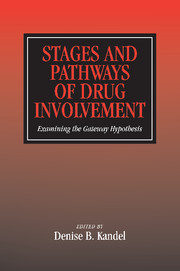Book contents
- Frontmatter
- Contents
- List of Contributors
- Foreword
- Preface
- Part I Overview
- Part II Recent Substantive Findings: What Do We Know About Stages of Drug Use, Risks, and Protective Factors?
- Part III Impact of Prevention Interventions: A Test of the Progression Hypothesis
- 6 Preventing the Onset and Developmental Progression of Adolescent Drug Use: Implications for the Gateway Hypothesis
- 7 The Gateway Theory Applied to Prevention
- 8 Intervention Effects on Adolescent Drug Use and Critical Influences on the Development of Problem Behavior
- Part IV Methodological Issues and Approaches: Advantages and Limitations of Alternate Methods
- Part V Animal Models and Biological Processes: Implications for Drug Progression
- Part VI Conclusion
- Index
8 - Intervention Effects on Adolescent Drug Use and Critical Influences on the Development of Problem Behavior
Published online by Cambridge University Press: 25 July 2009
- Frontmatter
- Contents
- List of Contributors
- Foreword
- Preface
- Part I Overview
- Part II Recent Substantive Findings: What Do We Know About Stages of Drug Use, Risks, and Protective Factors?
- Part III Impact of Prevention Interventions: A Test of the Progression Hypothesis
- 6 Preventing the Onset and Developmental Progression of Adolescent Drug Use: Implications for the Gateway Hypothesis
- 7 The Gateway Theory Applied to Prevention
- 8 Intervention Effects on Adolescent Drug Use and Critical Influences on the Development of Problem Behavior
- Part IV Methodological Issues and Approaches: Advantages and Limitations of Alternate Methods
- Part V Animal Models and Biological Processes: Implications for Drug Progression
- Part VI Conclusion
- Index
Summary
At least three different paradigmatic frameworks that guide behavioral science research (Biglan, 1995a, 1995b; Biglan & Hayes, 1996; Hayes, Hayes, & Reese, 1988) can be identified. Each is entirely defensible as an intellectual enterprise, yet each may not contribute equally to our ability to prevent or ameliorate problems of human behavior.
The most common framework guiding behavioral science research might be called mechanism, since it derives from the intellectual traditions of the physical sciences in which phenomena are conceived of as machinelike (Pepper, 1942). The key feature of this approach is the analysis of the phenomenon of interest into parts and the interrelationships of its parts. The validity of an analysis within this framework is judged by the degree to which a model of the parts and their interrelationships is confirmed by analyses of multiple samples of data. This validity or truth criterion has been labeled predictive verification. Because one can always construct a model for a given data set that perfectly fits that data set, there is a premium in this approach on showing that models are generalizable across a wide variety of samples.
A second, and somewhat less common framework has been labeled contextualism (Pepper, 1942). This approach derives from the American pragmatist philosophy. According to this approach, an analysis is said to be valid to the extent that it allows the analyst to achieve a stated goal.
- Type
- Chapter
- Information
- Stages and Pathways of Drug InvolvementExamining the Gateway Hypothesis, pp. 158 - 184Publisher: Cambridge University PressPrint publication year: 2002
- 7
- Cited by



